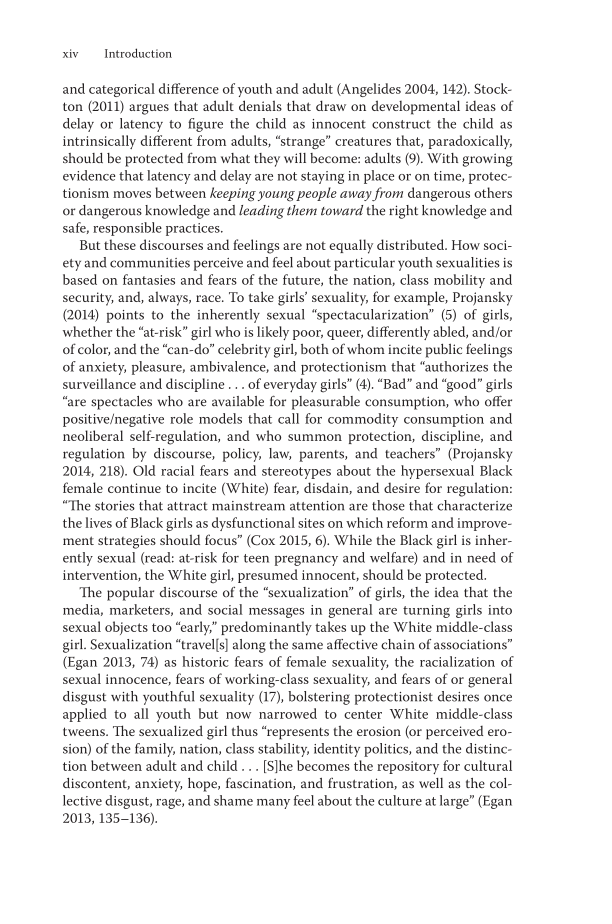xiv Introduction and categorical difference of youth and adult (Angelides 2004, 142). Stock- ton (2011) argues that adult denials that draw on developmental ideas of delay or latency to figure the child as innocent construct the child as intrinsically different from adults, “strange” creatures that, paradoxically, should be protected from what they will become: adults (9). With growing evidence that latency and delay are not staying in place or on time, protec- tionism moves between keeping young people away from dangerous others or dangerous knowledge and leading them toward the right knowledge and safe, responsible practices. But these discourses and feelings are not equally distributed. How soci- ety and communities perceive and feel about particular youth sexualities is based on fantasies and fears of the future, the nation, class mobility and security, and, always, race. To take girls’ sexuality, for example, Projansky (2014) points to the inherently sexual “spectacularization” (5) of girls, whether the “at-risk” girl who is likely poor, queer, differently abled, and/or of color, and the “can-do” celebrity girl, both of whom incite public feelings of anxiety, pleasure, ambivalence, and protectionism that “authorizes the surveillance and discipline . . . of everyday girls” (4). “Bad” and “good” girls “are spectacles who are available for pleasurable consumption, who offer positive/negative role models that call for commodity consumption and neoliberal self-regulation, and who summon protection, discipline, and regulation by discourse, policy, law, parents, and teachers” (Projansky 2014, 218). Old racial fears and stereotypes about the hypersexual Black female continue to incite (White) fear, disdain, and desire for regulation: “The stories that attract mainstream attention are those that characterize the lives of Black girls as dysfunctional sites on which reform and improve- ment strategies should focus” (Cox 2015, 6). While the Black girl is inher- ently sexual (read: at-risk for teen pregnancy and welfare) and in need of intervention, the White girl, presumed innocent, should be protected. The popular discourse of the “sexualization” of girls, the idea that the media, marketers, and social messages in general are turning girls into sexual objects too “early,” predominantly takes up the White middle-class girl. Sexualization “travel[s] along the same affective chain of associations” (Egan 2013, 74) as historic fears of female sexuality, the racialization of sexual innocence, fears of working-class sexuality, and fears of or general disgust with youthful sexuality (17), bolstering protectionist desires once applied to all youth but now narrowed to center White middle-class tweens. The sexualized girl thus “represents the erosion (or perceived ero- sion) of the family, nation, class stability, identity politics, and the distinc- tion between adult and child . . . [S]he becomes the repository for cultural discontent, anxiety, hope, fascination, and frustration, as well as the col- lective disgust, rage, and shame many feel about the culture at large” (Egan 2013, 135–136).
Document Details My Account Print multiple pages
Print
You have printed 0 times in the last 24 hours.
Your print count will reset on at .
You may print 0 more time(s) before then.
You may print a maximum of 0 pages at a time.
















































































































































































































































































































































































































































































































































































































